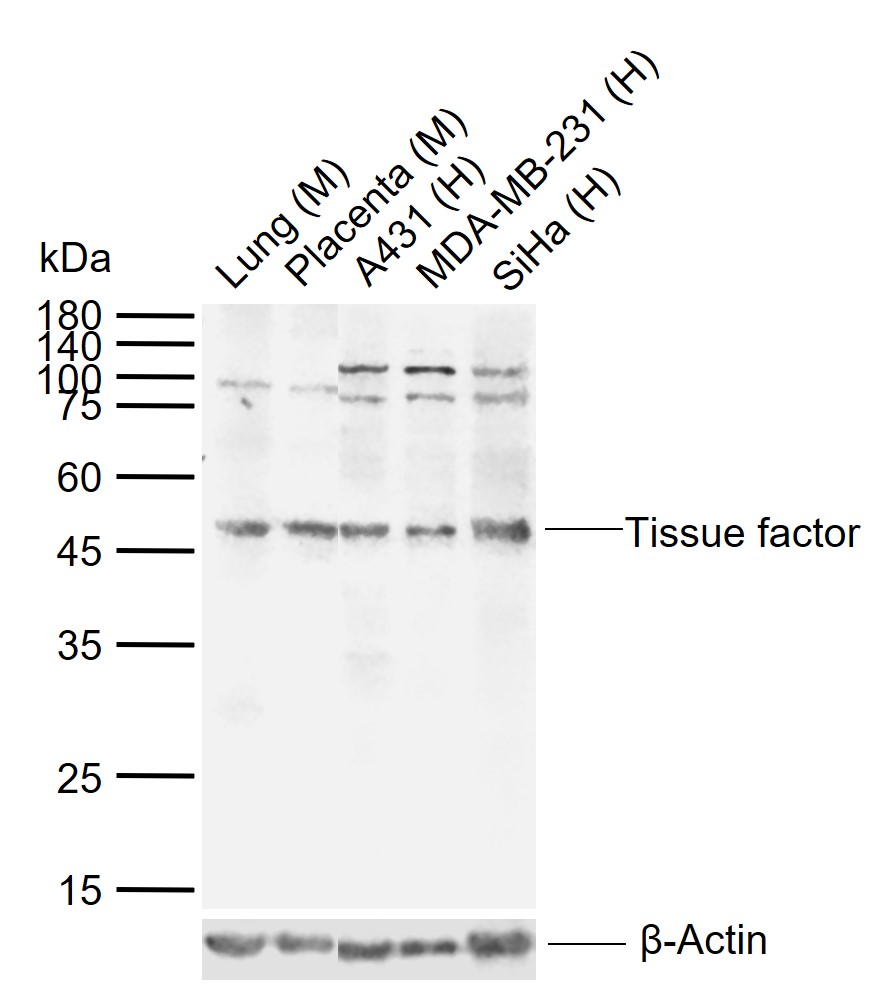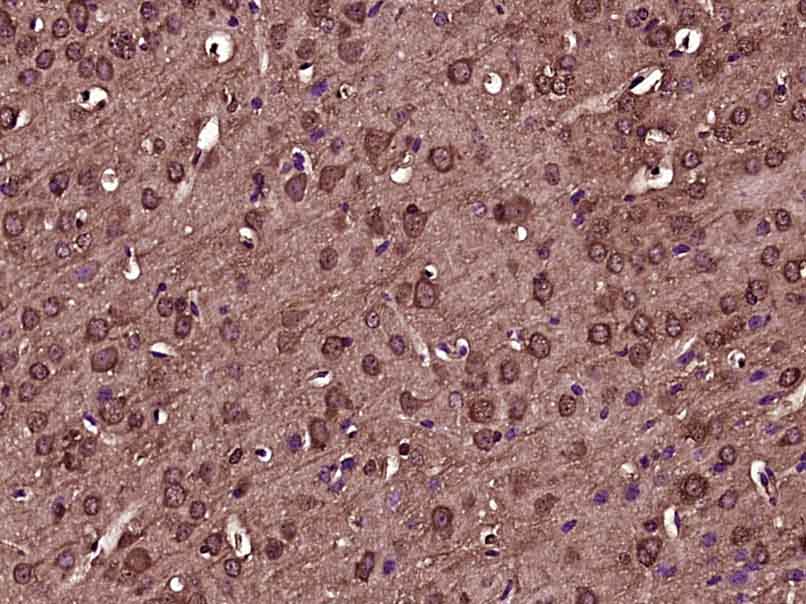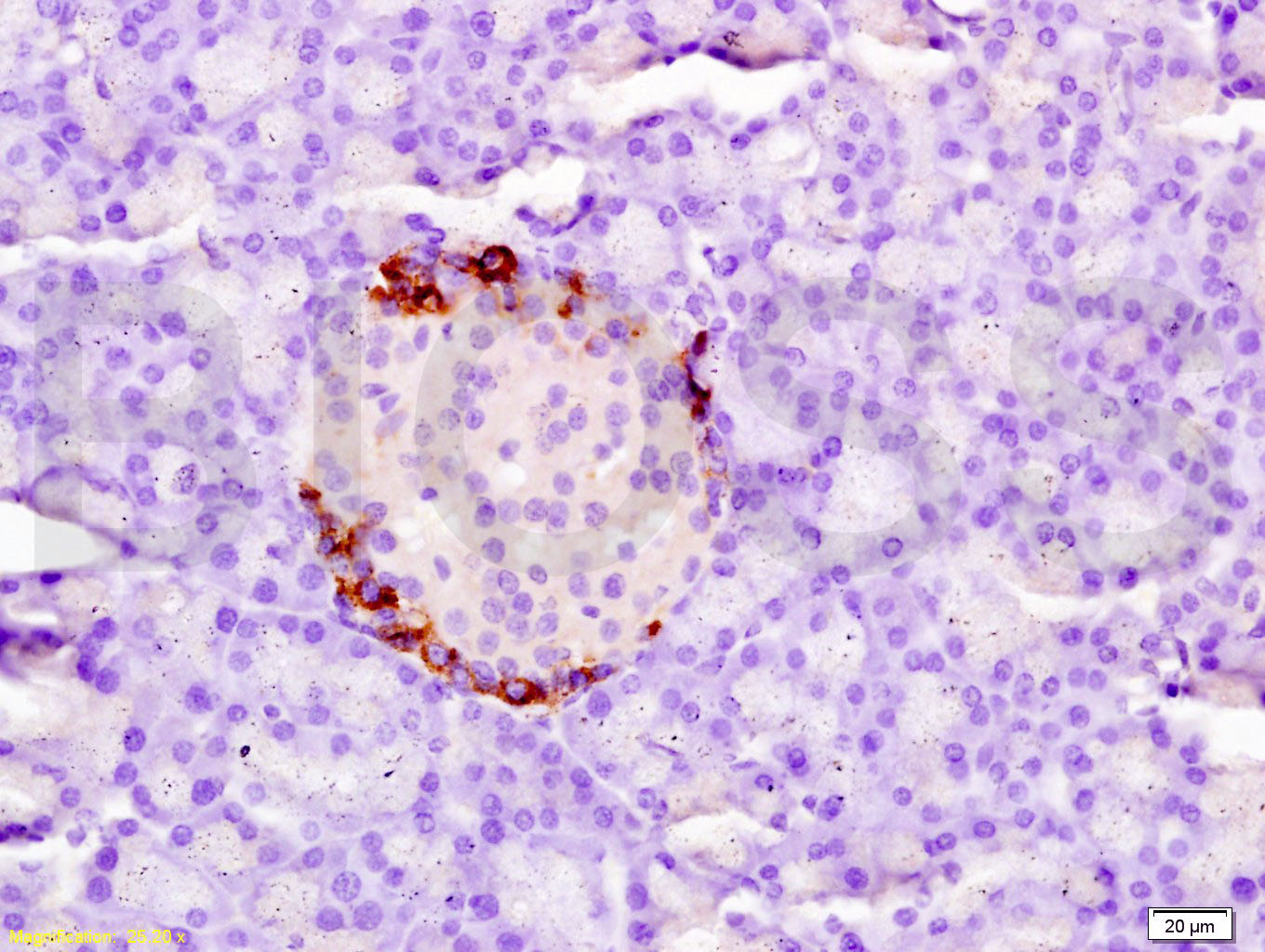
Rabbit Anti-Tissue factor antibody
CD 142; CD142; CD142 antigen; Coagulation factor III (thromboplastin tissue factor); Coagulation factor III; F3; TF; TFA; Thromboplastin; Tissue factor; TF_HUMAN.
View History [Clear]
Details
Product Name Tissue factor Chinese Name 组织因子(CD142)抗体 Alias CD 142; CD142; CD142 antigen; Coagulation factor III (thromboplastin tissue factor); Coagulation factor III; F3; TF; TFA; Thromboplastin; Tissue factor; TF_HUMAN. literatures Research Area Cell biology Growth factors and hormones Cell Surface Molecule Immunogen Species Rabbit Clonality Polyclonal React Species Human, Mouse, Rat, (predicted: Dog, Pig, Cow, Horse, Rabbit, Guinea Pig, ) Applications WB=1:500-2000 ELISA=1:5000-10000 IHC-P=1:100-500 IHC-F=1:100-500 IF=1:100-500 (Paraffin sections need antigen repair)
not yet tested in other applications.
optimal dilutions/concentrations should be determined by the end user.Theoretical molecular weight 29kDa Cellular localization The cell membrane Secretory protein Form Liquid Concentration 1mg/ml immunogen KLH conjugated synthetic peptide derived from human Tissue factor: 32-100/295 <Extracellular> Lsotype IgG Purification affinity purified by Protein A Buffer Solution 0.01M TBS(pH7.4) with 1% BSA, 0.03% Proclin300 and 50% Glycerol. Storage Shipped at 4℃. Store at -20 °C for one year. Avoid repeated freeze/thaw cycles. Attention This product as supplied is intended for research use only, not for use in human, therapeutic or diagnostic applications. PubMed PubMed Product Detail This gene encodes coagulation factor III which is a cell surface glycoprotein. This factor enables cells to initiate the blood coagulation cascades, and it functions as the high-affinity receptor for the coagulation factor VII. The resulting complex provides a catalytic event that is responsible for initiation of the coagulation protease cascades by specific limited proteolysis. Unlike the other cofactors of these protease cascades, which circulate as nonfunctional precursors, this factor is a potent initiator that is fully functional when expressed on cell surfaces. There are 3 distinct domains of this factor: extracellular, transmembrane, and cytoplasmic. This protein is the only one in the coagulation pathway for which a congenital deficiency has not been described. Alternate splicing results in multiple transcript variants.[provided by RefSeq, May 2010]
Function:
Initiates blood coagulation by forming a complex with circulating factor VII or VIIa. The [TF:VIIa] complex activates factors IX or X by specific limited protolysis. TF plays a role in normal hemostasis by initiating the cell-surface assembly and propagation of the coagulation protease cascade.
Subunit:
Interacts with HSPE; the interaction, inhibited by heparin, promotes the generation of activated factor X and activates coagulation in the presence of activated factor VII.
Subcellular Location:
Isoform 1: Membrane; Single-pass type I membrane protein.
Isoform 2: Secreted.
Tissue Specificity:
Lung, placenta and pancreas.
Similarity:
Belongs to the tissue factor family.
SWISS:
P13726
Gene ID:
2152
Database links:Entrez Gene: 2152 Human
Omim: 134390 Human
SwissProt: P13726 Human
Unigene: 62192 Human
Product Picture
Lane 1: Mouse Lung tissue lysates
Lane 2: Mouse Placenta tissue lysates
Lane 3: Human A431 cell lysates
Lane 4: Human MDA-MB-231 cell lysates
Lane 5: Human SiHa cell lysates
Primary: Anti-Tissue factor (SL4690R) at 1/1000 dilution
Secondary: IRDye800CW Goat Anti-Rabbit IgG at 1/20000 dilution
Predicted band size: 29 kDa
Observed band size: 50 kDa
Paraformaldehyde-fixed, paraffin embedded (Mouse brain); Antigen retrieval by boiling in sodium citrate buffer (pH6.0) for 15min; Block endogenous peroxidase by 3% hydrogen peroxide for 20 minutes; Blocking buffer (normal goat serum) at 37°C for 30min; Antibody incubation with (Tissue factor) Polyclonal Antibody, Unconjugated (SL4690R) at 1:400 overnight at 4°C, followed by operating according to SP Kit(Rabbit) (sp-0023) instructionsand DAB staining.Tissue/cell: rat pancreas tissue; 4% Paraformaldehyde-fixed and paraffin-embedded;
Antigen retrieval: citrate buffer ( 0.01M, pH 6.0 ), Boiling bathing for 15min; Block endogenous peroxidase by 3% Hydrogen peroxide for 30min; Blocking buffer (normal goat serum,C-0005) at 37℃ for 20 min;
Incubation: Anti-Tissue factor/CD142/F3 Polyclonal Antibody, Unconjugated(SL4690R) 1:200, overnight at 4°C, followed by conjugation to the secondary antibody(SP-0023) and DAB(C-0010) staining
References (0)
No References
Bought notes(bought amounts latest0)
No one bought this product
User Comment(Total0User Comment Num)
- No comment





 +86 571 56623320
+86 571 56623320
 +86 18668110335
+86 18668110335

